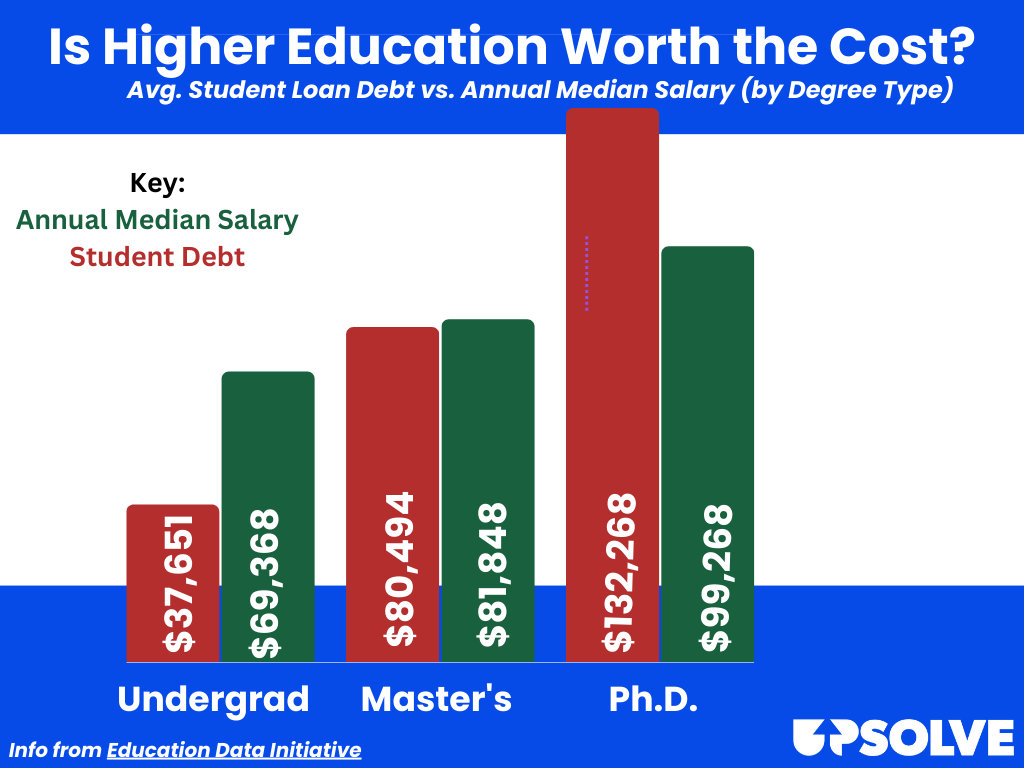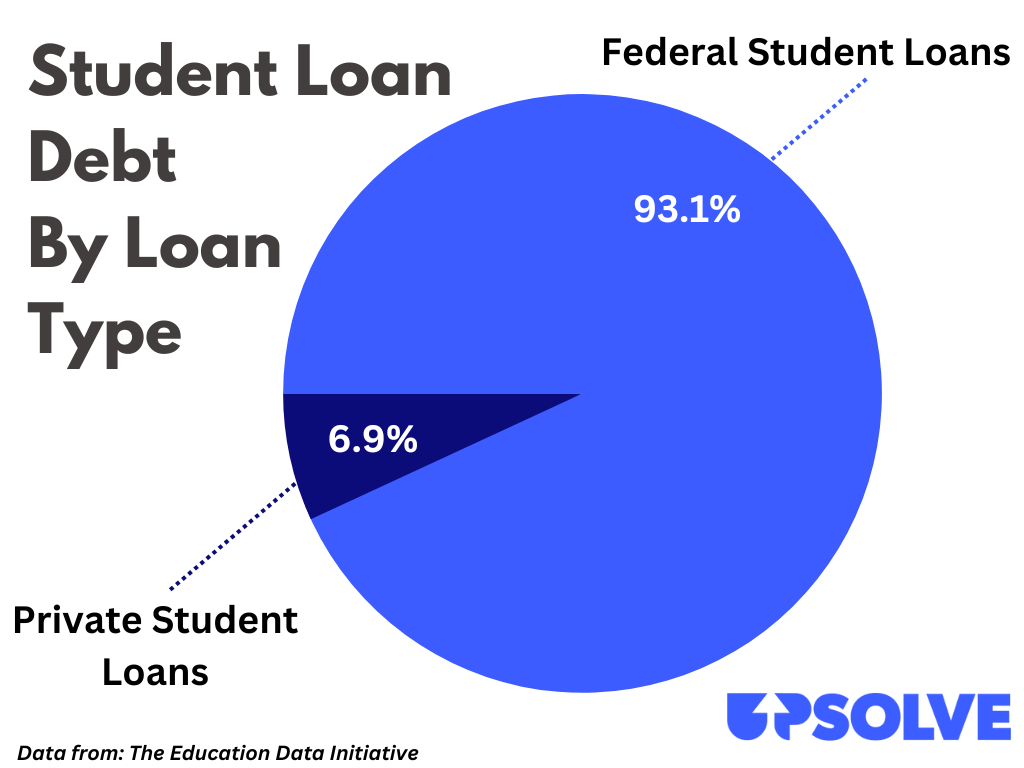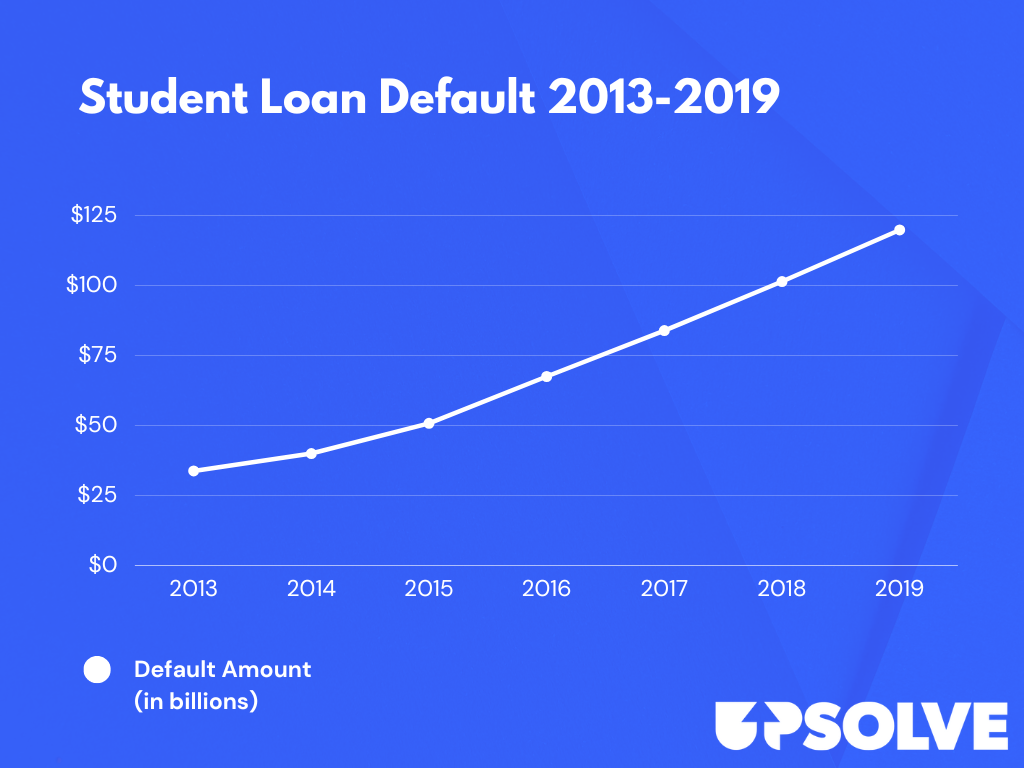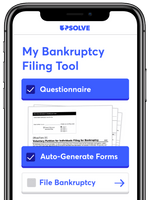Breaking Down the True Cost of College: The Harsh Reality of Student Loan Debt in 2023
Upsolve is a nonprofit that helps you get out of debt with education and free debt relief tools, like our bankruptcy filing tool. Think TurboTax for bankruptcy. Get free education, customer support, and community. Featured in Forbes 4x and funded by institutions like Harvard University so we'll never ask you for a credit card. Explore our free tool
As of 2023, the average amount of student loan debt for a borrower with a bachelor's degree is over $35,000, which has increased sixfold in the last two decades. About 93% of all student loan debt comes from federal student loans, while the rest is from private loans. Although federal student loans offer various repayment options, including income-driven repayment plans, forbearance, and deferment, many borrowers still fall behind on payments, leading to delinquency or default status. The student loan debt crisis has far-reaching implications, affecting not only individuals but also the U.S. economy.
Written by Jonathan Petts.
Updated March 25, 2024
What’s the Average Student Loan Debt in 2023?
The average balance for borrowers with a bachelor’s degree is over $35,000. To put that in perspective the average starting salary for 2023 graduates with a bachelor’s degree is about $63,400, according to a report by the National Association of Colleges and Employers.
To give you a sense of how this debt has grown for college students over time, Americans now owe six times as much in student loans as they did two decades ago, according to Duke Law. The same study found that student loan debt makes up 11% of all household debt, an increase from 4% just a decade ago. In fact, according to the Federal Reserve, student loan debt is now the second-highest consumer debt in the country, with mortgages being the only debt higher.
This amount of debt can take borrowers decades to pay off. And along the way, many will fall behind on student loan payments, causing the loans to fall into delinquency or default status, which can have serious financial consequences. More on this below in the section titled “The Troubling Consequences of Student Loan Default.”
Higher Education = Higher Debt
Not surprisingly, higher education translates to higher debt.

Students who opt to go on to graduate school take on 53% more debt to get a master’s degree than those with only a bachelor’s degree. And graduate students getting Ph.D.s come away with 72% more debt than undergrads.
While higher degrees correspond to higher incomes, you may be surprised at how this stacks up compared to the debt these students took on.
According to the Bureau of Labor Statistics (BLS), getting a master’s can net a 15% increase in annual salary (over having a bachelors), and having a Ph.D. nets you an almost 18% increase (over having a master’s). Neither keep pace with the increased debt. Curious about the actual numbers?
Here’s the median annual salary by education level according to the BLS:
Bachelor's: $69,368
Master’s: $81,848
Ph.D.: $99,268
Federal Student Loan Debt vs. Private Student Loan Debt: How Much Is There?
In 2023, total student loan debt in the United States reached an alarming level: over $1.75 trillion. The vast majority of this ($1.63 trillion) comes from federal student loans, while the rest ($122 million) is from private student loans, according to the Education Data Initiative (EDI).
Here’s the breakdown:

There are three main kinds of federal loans: Federal Direct Loans (including Direct Consolidation Loans), Federal Family Education Loans (FFEL), and Perkins Loans. Most federal student loan debt comes from Federal Direct Loans. Here’s the breakdown of outstanding debt and number of borrowers by loan type, according to the U.S. Department of Education, accurate of as March 2023:
| Federal Loan Types | Total Debt | % of Total Federal Debt | # Borrowers |
|---|---|---|---|
| Federal Direct Loans | $1.43 trillion | 87.7% | 38.3 million |
| FFEL Loans | $198 billion | 12.1% | 8.8 million |
| Perkins Loans | $3.8 billion | 0.2% | 1.3 million |
| Total | $1.63 trillion | 100% | 48.4 million |
In many ways, this is good news for borrowers because loans backed by the federal government tend to be much more flexible than loans from private lenders. Federal loan borrowers have access to several repayment options, including income-driven repayment (IDR) plans, deferment, and forbearance. Private lenders don’t typically offer such flexibility with repayment.
Federal loans also give borrowers more time to deal with delinquency (being late on or not making a payment) before it goes into default status. Private student loan borrowers can fall into delinquency much more quickly if they can’t make monthly payments.
Upsolve Member Experiences
1,997+ Members OnlineWhat’s the Impact of All This Student Loan Debt?
These statistics demonstrate the severity of the student loan debt crisis in the United States, which has a far-reaching impact on individuals and their financial situations and the U.S. economy. The rising cost of college can act as a gatekeeper, preventing some individuals from ever going beyond high school. This may have a disproportionate effect on students of color, leading to less diverse university classrooms and disparity in long-term economic outcomes and employment opportunities.
These expenses can also mean that new grads start their adult working lives saddled with tens of thousands of dollars of debt that some can never pay back fully. In fact, before the payment pause began in 2020, about 1 in 10 borrowers couldn’t pay back their student loans and were in default, according to the U.S. Department of Education.
When You Can’t Pay Your Student Loans: Deferment and Forbearance
Federal student loan borrowers who are unable to make their monthly payments can apply for temporary deferment and forbearance to pause their loan payments.
Deferment is a temporary pause on payments often granted for those experiencing economic hardship. During deferment, interest typically does not accrue on subsidized federal loans, but it does accrue on unsubsidized federal loans and private loans.
Forbearance is also a temporary pause on payments, but interest accrues on all types of loans. Forbearance is granted at the lender’s discretion and may be granted for reasons like unemployment or illness. Having a loan in forbearance, especially for a prolonged time, will increase the cost of the loan over time since interest continues to accrue.
To address the hardship many were facing due to the pandemic in March 2020, President Trump granted a mandatory administrative forbearance for all federal student loan borrowers, effectively pausing their monthly payments and temporarily reducing the interest rate to 0%. Under the same order, collection efforts for loans in default were also suspended to bring further financial relief.
Widely known as the student loan repayment pause, this popular program has been extended several times, but it will end in October 2023 leaving borrowers to figure out how to make monthly payments they haven’t had to make for years.
The Rising Problem of Student Loan Default & Why It Matters
Student loan default occurs when a borrower fails to make payments on their loan over time, typically 270 days or more for federal loans. This timeframe is often much shorter for private student loans.
When President Trump issued the pandemic-related order to temporarily suspend student loan payments, he also put a hold on collection efforts for any federal student loans in default status. This has provided a multiyear, albeit temporary, reprieve for borrowers in default. Looking at DOE data[1] prior to the 2020 suspension, one thing is abundantly clear: Student loan defaults were on the rise.

The Troubling Consequences of Student Loan Default
Defaulting on student loans can come with serious consequences and cause real and lasting financial harm. Here’s how default affects borrowers in their everyday lives:
A drop in credit score, which can impact employment and housing opportunities as well as financial prospects
Wage garnishment or tax refund garnishment, which can make it difficult to pay basic living expenses and cause serious long-term financial harm
Additional collection fees and the stress of dealing with a debt sent to collections
A loss of eligibility for federal financial aid
According to the Pew Charitable Trusts Student Borrower Survey, about 84% of borrowers who defaulted on their student loans have experienced at least one of these consequences. About 59% of borrowers who defaulted reported experiencing two or more consequences. Many borrowers reported that these consequences had “a major financial impact” on their lives.
And while the majority of borrowers (82%) said they knew there would be consequences for not paying their student loans, much fewer (about 40%) knew what those consequences might be or how they might impact their financial situation. If you’ve ever dealt with a surprise emergency expense, you can understand how suddenly having your wages garnished or a debt sent to collections can cause serious stress and a scramble to stay afloat financially.
Remember, most student loans are federal loans, and most federal loans are Direct Loans. Direct student loans do not require a credit check or co-signer, which makes them relatively easy to get. This may feel like easy money to college students who don’t fully understand the consequences of not being able to pay it back after they graduate or drop out.
Is Student Loan Forgiveness Decreasing the Student Debt Burden?
Despite dominating the public conversation in recent years, student loan forgiveness isn’t helping as much as you might think.
The Department of Education (DOE) has provided $24 billion in loan relief to 360,000 borrowers through the popular Public Student Loan Forgiveness (PSLF) program. While that number may sound high, it represents less than 1.5% of all student loan debt.
Further, recent data from the federal government shows that only a small percentage (2.4%) of the over 2 million PSLF forms submitted have met the requirements for relief under the program. The remaining forms are labeled as “did not yet meet requirements.” Borrowers who submitted these forms may benefit from the Biden administration’s permanent changes to the PSLF program that take effect this year. We’ll see the effects in coming months.
Meanwhile, President Biden’s income-based student loan forgiveness plan was shot down by the Supreme Court in July 2023. It was slated to help some 27 million borrowers wipe out up to $20,000 of student loan debt, or a projected total of about $540 billion. The Biden Administration is working on changing income-driven repayment options to make monthly payments more affordable and shortening the length of time until borrowers on these plan can get forgiveness.
Drowning in Student Loan and Other Debt? Here’s an Option You May Not Have Considered!
If you're drowning in student loan debt and other types of debt (credit card debt, medical bills, payday loans, etc.) and you’ve tried other debt relief options, you may want to consider filing for bankruptcy. Chapter 7 or Chapter 13 bankruptcy can help you erase your debt and start fresh financially. The truth is that some individuals may never be able to pay off their loans in their lifetime. This is a heavy burden to bear year after year, so it is worth it to evaluate all your options.
To discharge your student loans through bankruptcy, you'll need to file an adversary proceeding after filing your bankruptcy case and prove that paying off the debt would cause undue hardship. In the past, this was a challenging process, but new guidelines from the Department of Justice make it easier to navigate for the millions of borrowers who have direct federal loans.
If you want to learn more about how to file bankruptcy on student loans, check out our article Yes, You Can File Bankruptcy on Student Loans. Here’s How. If you’re ready to take action, Upsolve may be able to help you through the process for free. See if you’re eligible now.
Sources:
- StudentAid.gov (US Dept of Education). (n.d.). Portfolio by Loan Status (DL, FFEL, ED-Held FFEL, ED-Owned). Federal Student Loan Portfolio. Retrieved May 10, 2023, from https://studentaid.gov/data-center/student/portfolio












